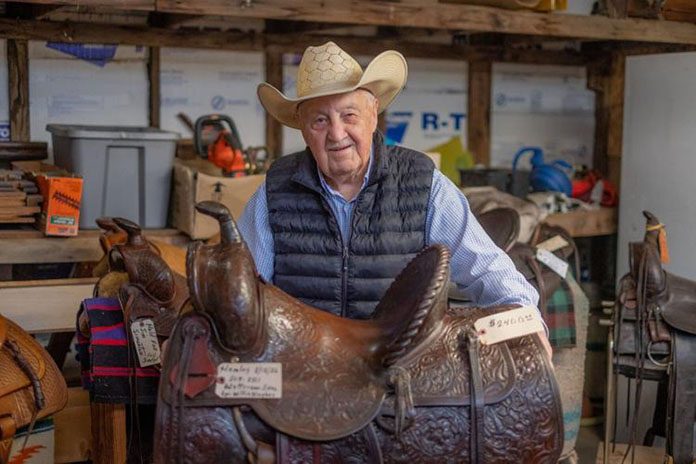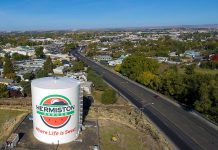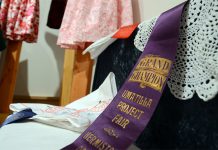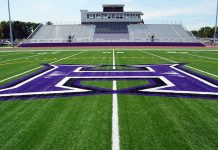
Eastern Oregon has a retired rancher who will not be kept far from a saddle.
Floyd Lewis was born into the ranching.
“My dad was in the cattle industry when I was a year old,“ Lewis said. “He was also a cattle broker. Then during World War II, he operated a meatpacking company in Grants Pass, so I grew up with the cattle industry from day one.”
As he got a little older, Lewis worked on his uncle’s cattle ranch on the Umpqua River country out of Canyonville.
“From the time I was old enough to saddle a horse I was riding when I wasn’t in school,” Lewis said.
Lewis, who is approaching his 93rd birthday in March, bought his first ranch in the Rogue River Valley in 1953, and everything kept growing from there.
“I then migrated to Hermiston for 20 years to manage the Northwest Livestock Auction yard out on Interstate 84, and while I was there, we started horse sales,” Lewis said. “When I started there in 1958 It was all cattle. We started horse sales in 1959.”
Lewis said he remembers selling horses for 23 hours straight with no rest.
“I was in the office all that time, but the auctioneers were selling horses from 9 a.m. Sunday to 8 a.m. Monday,” Lewis said
“We had one of the biggest horse sales in the western United States,” Lewis said. “We attracted horses down from Canada, out of the East, Midwest from Nebraska, from Montana, the Dakotas, all the way out for our horse sales.”
The auction had the necessary infrastructure to support all that.
“The livestock facilities were set up to handle 2,000-3,000 head of cattle on a weekly basis,” Lewis said, “and the horses probably never had over 800-1,000 head, but they had to be cared for individually. We didn’t do the personal care, but we provided the facilities and then did the auction.”
Lewis said the auction had the services of a yard veterinarian who was present for all the cattle and horse sales, “and kept pretty good surveillance on all the health and care of the livestock.”
Lewis said he presided over the livestock auction yard until 1961.
“Then, having been in the livestock industry all my life, I migrated over into the ranch real estate business,” Lewis said. “I was a ranch broker on commission. But all the time from 1953 on, I had a purebred Angus cattle operation that I managed along with whatever other business I was in.”
“We screened birth weights, weaning weights and yearling weights,” Lewis said, “and recorded all of the performance on the cattle.”
Lewis said the high point of his business was when he sold a heifer calf for about $51,500.
“That was a pretty important day,” he said.
Lewis said he had a bull calf sell for about $31,000.
Lewis eventually sold the ranch and returned to the Walla Walla Valley where he began leasing cattle. He provided 100 head of Holsteins to Walla Walla College, and also acquired about 200 head of Charolais.
“I did that until I was in my 80s,” Lewis said.
His interest in restoring antique saddles developed about 10 years earlier.
That began when he had dropped off a saddle of his own to have some repairs done and didn’t get any response for several months, “while I needed it,” he said, “so I took it back home and did the repairs myself.”
Lewis enjoyed the work and thought, “maybe I’ll watch for some nice antique saddles. At this point I’ve probably cleaned and restored about 300 saddles.”
He said the oldest was dated 1888 and was made by Sherman Loomis at his shop in Santa Barbara, California.
“I think the highest-priced saddles I’ve sold have been in the $3,000 bracket,” Lewis said.
There are several of his restored saddles available for purchase at Rod Retherford’s saddle and tack shop in Pendleton and also Bordertown Feed & Supply in Milton-Freewater.
Lewis also keeps himself occupied by buying manufactured chaps and covering them with a variety of animal furs. He says these sell readily, but the buyers are much more likely to mount them to a wall as artwork than wear them.
Lewis could be Webster’s illustration in defining the word “active.”
Pendleton saddlemaker Rod Retherford describes Lewis as a “cool, cool cowboy with lots of stories. He just amazes me. He’s 93 years old, and he’ll come in carrying two saddles, one on each hip, throw them up on a rack and say, ‘I’ll be right back.’ Then he’ll go out and grab another one. He’s an inspiring old cowboy to me.”









